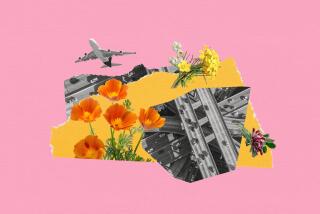Kauai’s Limahuli Garden & Preserve showcases the ancient Polynesians’ ‘botanical tool kits’
Reporting from Hanalei, Hawaii — For all of Hawaii’s natural wonders, enjoying a forest here in its native state isn’t easy. You can endure a strenuous hike in the mountains — or you could drive past Hanalei Bay on the North Shore of Kauai to a parcel of magnificent terrain presided over by the lush twin peaks of Makana Mountain.
Today, the area comprises the Limahuli Garden & Preserve, a botanical masterpiece housing archaeological sites linked by a trail highlighting about 250 species of plants. These include those carried here by Polynesians as well as later introductions to the island.
Limahuli is one of five National Tropical Botanical Gardens in the U.S., three of which are on Kauai. But the Allerton and McBryde gardens on the more developed southern side of the isle offer a less natural experience.
A visit to the 23-year-old Limahuli Preserve is often combined with a day trip to the Kalalau Trail (the only land access to the secluded Na Pali Coast) just half a mile away.
I arrived at the garden eager to learn about early Hawaii. I was awestruck by the Limahuli Valley, in the shadow of Makana Mountain, the inspiration for Bali Hai in the 1958 blockbuster “South Pacific.”
It was hard not to be mesmerized by the green hues and velvet-like textures of the vegetation framed by a blue sky dotted with fast-moving white clouds.
Limahuli, which means “turning hands,” is much more than just a pretty place. Said Kawika Winter, the garden’s director: “People drive to the end of the road … hike the trail and look at the coastline, but what many don’t recognize is that they’re standing in the most biodiverse eco region of the entire [Hawaiian] archipelago in a place with a very deep cultural history.”
The 17-acre garden, set in the narrow valley, is a living demonstration of resource management developed and practiced by the Polynesians, said to have arrived on the island as early as 200.
And those turning hands? They refer to those responsible for building lava rock terraces, which supported the growth of taro, a source of nutrition for the ancient people.
I encountered those terraces, still planted with taro, on the way to the Canoe Garden, my first stop as I snaked my way uphill on a self-guided tour along the three-quarter-mile loop trail.
This particular garden, so named because many of the plants were carried here by Polynesians in their canoes, is set among the archaeological vestiges of a farming complex that once sustained the community and is thought to be one of the Hawaiian Islands’ earliest settlements.
“Our ancestors packed their canoes with these ‘botanical tool kits’ — all the things needed to survive: food, clothing medicine, religion and ceremonial items,” Winter said.
The islands at that time had few edible plants and, except for some flightless birds, no mammals to hunt. No wonder those vessels were packed with some 27 varieties of plants along with jungle fowl, pigs, rats and dogs.
As I climbed higher, I passed patches of sweet potato, banana and turmeric, finally arriving at a display of niu, or coconut palm. It too was brought by the Polynesians.
The same goes for ko, or sugar cane, also planted here. This member of the grass family once constituted an important industry in the state, but the last plantation — on Maui — closed in 2016.
I also encountered a stand of awapuhi, or shampoo ginger, known for its hair-moisturizing properties. In late summer, it reveals red or purple flower heads and a soapy, aromatic sap.
The Plantation Era Garden, named for the plants brought to the islands in the last 200 years, was my final stop along the trail.
Winter described it as “more emblematic of the landscaping you see around family homes. Many of the plants that have become iconic symbols of Hawaii, like the pineapple and the bird-of-paradise flower, actually have very shallow connections to Hawaiian culture.”
These plants and the brightly colored orchids, mango, papaya, gardenia and even plumeria arrived with immigrant workers for those sugar plantations.
I contemplated all this at one of my favorite spots in the garden, the path that runs alongside Limahuli Stream. There’s nothing like flowing water to calm the minds and bring the whole scene into sharp relief.
“It’s one of the last pristine streams in all of Hawaii. Even just to get a moment to sit and observe that — it’s very Zen-like,” Winter said.
It’s also the ideal place to thank those ancient and not-so-ancient settlers for making this place the verdant paradise it is today.
If you go
THE BEST WAY TO KAUAI
From LAX, United, American, Delta and Hawaiian offer nonstop service to Lihue, Kauai. Restricted round-trip airfares from $536, including taxes and fees.
Limahuli Garden & Preserve, 5-8291 Kuhio Highway, Hanalei, Hawaii. Self-guided tours 9:30 a.m.-4 p.m. Tuesdays-Saturdays. $20 for adults, $10 for children younger than 17. Private, custom, docent-led and family tours also available.
ALSO
How to save big on Hawaii Island
Keep your costs down, fun factor up on Oahu
Hawaii’s snack li hing is everywhere: margaritas, malasadas and more
More to Read
Sign up for The Wild
We’ll help you find the best places to hike, bike and run, as well as the perfect silent spots for meditation and yoga.
You may occasionally receive promotional content from the Los Angeles Times.






